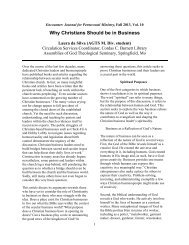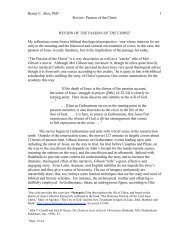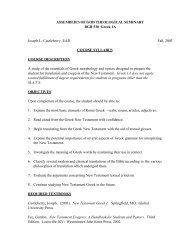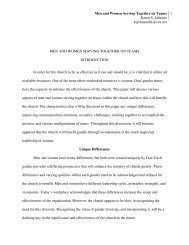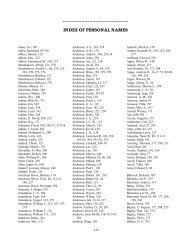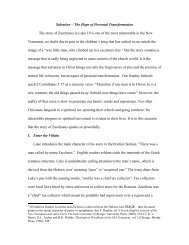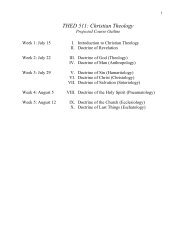Encounter: Journal for Pentecostal Ministry - Assemblies of God ...
Encounter: Journal for Pentecostal Ministry - Assemblies of God ...
Encounter: Journal for Pentecostal Ministry - Assemblies of God ...
Create successful ePaper yourself
Turn your PDF publications into a flip-book with our unique Google optimized e-Paper software.
them 8 because women were not educated in<br />
the Torah. 9 Rabbis did not want to educate<br />
women in the Law and, as a result, men<br />
treated women with little respect and<br />
believed they could not contribute to the<br />
conversation. 10<br />
The words Jesus used in public indicated<br />
His intentional defiance <strong>of</strong> the cultural<br />
practice <strong>of</strong> treating women as subordinate<br />
beings. 11 In contrast to the norm, Jesus<br />
communicated spiritual truths using parables<br />
that highlighted women as the heroines. 12<br />
Jesus described His prophetic role with<br />
feminine metaphors (Matt. 23:37-39). 13<br />
When He taught about marriage, He<br />
equalized the roles, responsibilities, and<br />
rights <strong>of</strong> husband and wife. 14 He held private<br />
and lengthy conversations with women. 15<br />
Some <strong>of</strong> His most significant conversations<br />
recorded in the Gospels were with women.<br />
On His way to Golgotha, Jesus prophesied<br />
to the women mourning His death (Luke<br />
23:27-31). The final group Jesus spoke to<br />
be<strong>for</strong>e the cross consisted <strong>of</strong> women. 16<br />
Actions<br />
Jesus used His actions to equalize and<br />
assimilate women into His Kingdom. He<br />
removed the woman‟s responsibility <strong>for</strong><br />
male lust (Matt. 5:27-30). 17 He defended<br />
women in public. The Gospel <strong>of</strong> John<br />
records the account <strong>of</strong> the woman caught in<br />
adultery; Jesus acts extraordinarily by<br />
defending her, confronting her accusers, and<br />
placing equal responsibility upon the man<br />
<strong>for</strong> this sin (8:1-11). 18 He blessed men and<br />
women in the same way. 19 He allowed<br />
women to touch Him to receive healing. 20<br />
He also touched women and allowed a<br />
prostitute to wipe away tears with her<br />
uncovered hair (Luke 7:36-50). 21 The<br />
significance <strong>of</strong> Jesus touching the crippled<br />
woman in Luke 13:10-17 reveals his<br />
2<br />
intention to break cultural and religious<br />
barriers to right relationship. 22<br />
Jesus restored dignity and social status. 23 He<br />
assimilated women into His ministry. The<br />
Gospel <strong>of</strong> Luke records females financially<br />
supporting and, most likely, ministering<br />
alongside Christ while traveling with Him<br />
(Luke 8:2-3). 24 Radical, counter-cultural<br />
actions helped equalize and assimilate<br />
women into His Kingdom. As a result <strong>of</strong><br />
Jesus‟ words and actions, women responded<br />
to His message gladly, discovering a new<br />
identity. 25<br />
Relationships<br />
Jesus developed healthy relationships with<br />
women, equalizing and assimilating them<br />
into His Kingdom. Jesus included women in<br />
His ministry team, and some theologians<br />
suggest that His female followers described<br />
in Luke 8 functioned as disciples. 26 Unlike<br />
other rabbis, Jesus allowed both male and<br />
female disciples to accompany Him on His<br />
travels. 27 Scripture provides numerous<br />
examples <strong>of</strong> Jesus interacting with women,<br />
revealing how He broke barriers associated<br />
with race, class, and sex. 28 The Gospels<br />
highlight the female presence in Jesus‟<br />
ministry at the cross and resurrection,<br />
revealing the loyalty <strong>of</strong> these women (Matt.<br />
28; John 19:25-27; 20:1-18). They were true<br />
disciples <strong>of</strong> Jesus—something other rabbis<br />
would not allow. 29<br />
Jesus‟ closest friends included Mary,<br />
Martha, and Lazarus. Interestingly, more is<br />
written about Mary and Martha than about<br />
Lazarus. 30 Jesus taught Mary in her own<br />
home in the same manner as He did male<br />
disciples. 31 Normally, this advanced<br />
education remained exclusive to male<br />
students, 32 yet Jesus affirmed Mary as she<br />
stepped outside a woman‟s traditional<br />
domestic sphere because He was<br />
unconcerned with upholding gender-based





